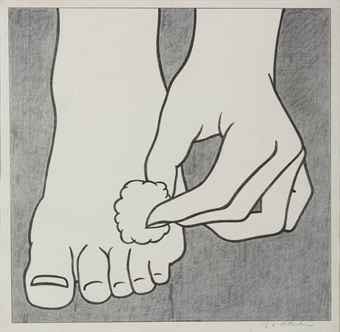
Of most interest is how Disney trains its employees to deliver that happy feeling to its paying customers. […]
Research suggests that Disney employees actively involved in surface acting are more likely to experience emotional exhaustion.
{ BPS | Continue reading }
psychology |
September 28th, 2012

Researchers at the Fred Hutchinson Cancer Research Center have found traces of male DNA in women’s brains, which seems to come from cells from a baby boy crossing the blood-brain barrier during pregnancy. This is known as microchimerism, and according to the researchers, this is the first description of male microchimerism in the female human brain.
{ Genome Engineering. | Continue reading }
brain, genes |
September 28th, 2012

{ The US Naval Surface Warfare Center has created an Android app that secretly records your environment and reconstructs it as a 3D virtual model for a malicious user to browse. | The Physics arXiv Blog }
spy & security, technology |
September 28th, 2012
gross, haha |
September 27th, 2012

Gonorrhea is the second most commonly reported infectious disease in the United States, after Chlamydia. And it’s on the rise, with the CDC reporting more than three hundred thousand new cases each year, because young people are giving head without using any sort of protection. But how can you convince sexually inexperienced youngsters — who are often already nervous about rounding the bases in the “right way” illustrated by porn and pop culture — to use condoms for blow jobs? Like, who does that?
First, a quick gonorrhea FAQ: Most people think of gonorrhea as something that festers down below, but the STI is actually way more likely to get passed onto others via the throat, particularly through blow jobs. (Kissing and cunnilingus don’t spread it because saliva contains enzymes that destroy gonorrhea. Thanks, saliva.) […]
Gonorrhea is way, way more contagious than HIV: A woman who has unprotected sex with an HIV carrier has about a one-in-a-thousand chance of testing positive for the virus, but a woman who has unprotected sex with a gonorrhea carrier has a sixty-six percent chance of getting infected.
{ Jezebel | Continue reading }
photo { Air Sex World Championships }
health, sex-oriented |
September 27th, 2012

Deisseroth is developing a remarkable way to switch brain cells off and on by exposing them to targeted green, yellow, or blue flashes. With that ability, he is learning how to regulate the flow of information in the brain.
Deisseroth’s technique, known broadly as optogenetics, could bring new hope to his most desperate patients. In a series of provocative experiments, he has already cured the symptoms of psychiatric disease in mice. Optogenetics also shows promise for defeating drug addiction. […]
For all its complexity, the brain in some ways is a surprisingly simple device. Neurons switch off and on, causing signals to stop or go. Using optogenetics, Deisseroth can do that switching himself. He inserts light-sensitive proteins into brain cells. Those proteins let him turn a set of cells on or off just by shining the right kind of laser beam at the cells.
That in turn makes it possible to highlight the exact neural pathways involved in the various forms of psychiatric disease. A disruption of one particular pathway, for instance, might cause anxiety.
{ Discover | Continue reading }
brain, health, neurosciences, science, technology |
September 27th, 2012

Google Chairman Eric Schmidt says Apple should have continued to use Google’s mapping application in iOS 6 instead of swapping it out for its poorly received home-brewed replacement, and given the sour reception Apple’s Maps app has been given, he may have been right.
But multiple sources familiar with Apple’s thinking say the company felt it had no choice but to replace Google Maps with its own, because of a disagreement over a key feature: Voice-guided turn-by-turn driving directions.
{ All Things D | Continue reading }
related { Ecce Homo }
economics, google, within the world |
September 27th, 2012

For a long time, I had been in a dark, painful mood, a mood that had steadily transitioned into my personality. When I felt anger, I felt it so intensely that it took over my whole body. I would go to the grocery store with a carefully composed list, walk through the aisles fuming, and then leave so furious that I completely forgot to buy any food. The anger—which could have been over anything from a fight with a friend to a political issue—often lasted for weeks. Also, I was tired—always, always bone-tired. I was so exhausted that it was a huge physical effort to sit at my desk and type, except for rare weeks of nonstop energy in which I came up with an idea, worked to make it happen, watched it happen, and then treated it like a toy I’d gotten bored with after several days. I could always get my paying work done, but anything outside of that was subject to my ever-fluctuating energy levels. My emotions seemed remote, flat, hard to discern, as if I were trying to see them through dirty glass. I couldn’t really feel anything, and what I could feel was bad. I pulled away from people. I was determined not to trust anyone. I was depressed, in other words, except for those strangely productive weeks and long, terrifying rushes of anger. […]
I had been diagnosed in the past with depression and generalized anxiety disorder, both of which were common illnesses, and which I thought explained my problems. I would have been insulted if you’d suggested I had anything more serious. […]
What the doctors at the hospital finally decided was that I had bipolar II disorder, which is a scary diagnosis. It has a high suicide rate and can be very painful and destructive to your life if you don’t get it treated. It basically means cycling between phases of overconfidence and recklessness (and/or anger), and then deep shame when you crash down into depression and see the mess you’ve made.
{ Rookie Mag | Continue reading }
photo { John Divola }
experience, psychology |
September 27th, 2012

How did people wake up on time before the invention of the alarm clock?
Early man drank tons and tons of water if he needed to wake up before the sun.
{ Quora | Continue reading }
guide |
September 26th, 2012

{ Peter Turchin suggests, based on prior trends, that the US is in for a new period of political instability peaking around 2020. He finds that historically US instability has peaked about every fifty years. He also found this 50 years cycle in Roman and French history, but not in Chinese history. | Overcoming Bias | full story }
economics, ideas |
September 26th, 2012
ideas, photogs |
September 25th, 2012

The 2012 Ig Nobel Prize Winners
PSYCHOLOGY PRIZE: Anita Eerland and Rolf Zwaan [THE NETHERLANDS] and Tulio Guadalupe [PERU, RUSSIA, and THE NETHERLANDS] for their study “Leaning to the Left Makes the Eiffel Tower Seem Smaller.”
[…]
PEACE PRIZE: The SKN Company [RUSSIA], for converting old Russian ammunition into new diamonds.
NEUROSCIENCE PRIZE: Craig Bennett, Abigail Baird, Michael Miller, and George Wolford [USA], for demonstrating that brain researchers, by using complicated instruments and simple statistics, can see meaningful brain activity anywhere — even in a dead salmon.
{ Improbable Research | Continue reading }
haha, neurosciences, psychology, science |
September 25th, 2012

Castration had a huge effect on the lifespans of Korean men, according to an analysis of hundreds of years of eunuch “family” records.
They lived up to 19 years longer than uncastrated men from the same social class and even outlived members of the royal family.
The researchers believe the findings show male hormones shorten life expectancy.
{ BBC | Continue reading }
genders, hormones, science |
September 25th, 2012

The wealthiest 10% have gotten rich mainly by getting the bottom 90% into debt. And labor (“consumers”) try to escape from their financial squeeze by going even deeper into debt, to buy homes and status before their access price rises even further out of reach. But what is pushing up real estate and other prices is easy bank credit – that is, debt. So the debt expansion calls for yet more debt to keep the financial system solvent.
This is not industrial capitalism as analyzed by the classical economists. It is something quite different. It is a regression to the ancient usury problem that destroyed Rome. […]
Richard Price, an actuarial mathematician, had warned n 1772, that all the government’s income would soon be spent on interest on its war debt. To explain the problem to the public, he chose the example of a penny invested at the time of Jesus Christ at five percent interest. At simple interest – just paying the five percent each year – the interest would amount to a total 7 shillings and 12 pence by his day. However, reinvesting this interest as it fell due would accrue an amount equal to a solid sphere of gold as large as 120 earths. And if this penny had been left to accrue and reinvest interest at six percent, it would have amounted in value to a solid sphere of gold extending from the sun’s orbit all the way out to Saturn.
{ Michael Hudson | Continue reading }
economics |
September 25th, 2012
 Hospital removes ‘asparagus-sized’ eel from man’s bottom.
Hospital removes ‘asparagus-sized’ eel from man’s bottom.
Beauty pageant officials in China demanded a minimum nipple spacing for contestants. [via The Beheld]
Humans were already recycling 13,000 years ago.
How the mere presence of a mobile phone harms face-to-face conversations.
Brain study reveals the roots of chocolate temptations.
The rotten egg gas leaking from sewer pipes and costing billions of dollars worldwide in odour control may soon be far less of a problem thanks to a magic mix of chemicals, called Cloevis.
In the euro zone, only Greece has government debt approaching the Japanese level.
Stealing magic has become a commonplace crime. Teller, a man of infinite delicacy and deceit, decided to do something about it.
It’s 30 years since the death of Glenn Gould, but the pianist still provokes strong reactions. So how do today’s top players assess his legacy?
11 Historical Geniuses and Their Possible Mental Disorders. [Thanks Tim]
List of English contractions and List of camouflage patterns. [via List of lists on Wikipedia]
The Velvet Underground and Nico, Press Release.
Louis CK just hanging out.
This letter was sent to a Russian student by her French friend, who manually wrote the address that she received by e-mail. Her e-mail client, unfortunately, was not set up correctly to display Cyrillic characters, so they were substituted with diacritic symbols from the Western charset (ISO-8859-1). The address was deciphered by the postal employees and delivered successfully.
The soul-brother handshake. [Survival City Guide]
every day the same again |
September 25th, 2012

Imagine a clock that will keep perfect time forever, even after the heat-death of the universe. This is the “wow” factor behind a device known as a “space-time crystal,” a four-dimensional crystal that has periodic structure in time as well as space. However, there are also practical and important scientific reasons for constructing a space-time crystal. With such a 4D crystal, scientists would have a new and more effective means by which to study how complex physical properties and behaviors emerge from the collective interactions of large numbers of individual particles, the so-called many-body problem of physics. A space-time crystal could also be used to study phenomena in the quantum world, such as entanglement, in which an action on one particle impacts another particle even if the two particles are separated by vast distances.
{ Berkeley Lab | Continue reading }
technology, time |
September 25th, 2012

{ Corinne May Botz, Apartment No.2, Brooklyn, New York | Haunted Houses is a long-term project in which I photographed and collected oral ghosts stories in over eighty haunted sites throughout the United States. | image gallery + listen to ghost stories | Alice Austen House Museum, Staten Island, NY until Dec. 30, 2012 }
photogs, weirdos |
September 24th, 2012

It would be difficult to be strong at chess if you had a subnormal IQ, but you certainly don’t need an IQ of above average. I’m sure you could find very strong grandmasters with IQs around about the 100 mark, which is the average. […]
What I have noticed in very strong players, though, is an extraordinary degree of concentration. You really do have to concentrate very hard for long periods. There is a very boring phrase for that, which is hard work. That’s often underestimated, while the idea of effortless genius is greatly overestimated.
{ Dominic Lawson/The Browser | Continue reading }
chess, ideas |
September 24th, 2012

The Lancet has a wonderful article on how medicine has understood how strange objects have ended up in the body and how this has influenced our understanding of the body and behavior.
The piece notes that cases where people have swallowed or inserted foreign bodies into themselves have been important for surgery and even anatomy – hair swallowers apparently provided useful “hair casts of the stomach.”
{ Mind Hacks | Continue reading }
science, weirdos |
September 24th, 2012






















